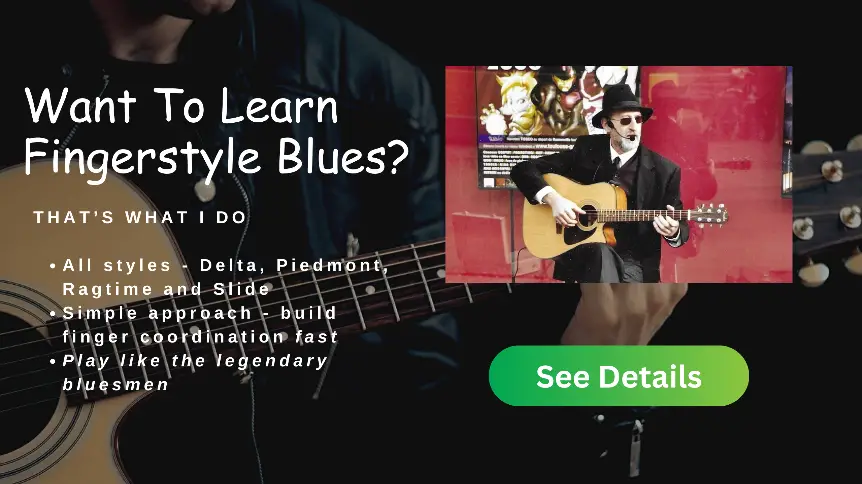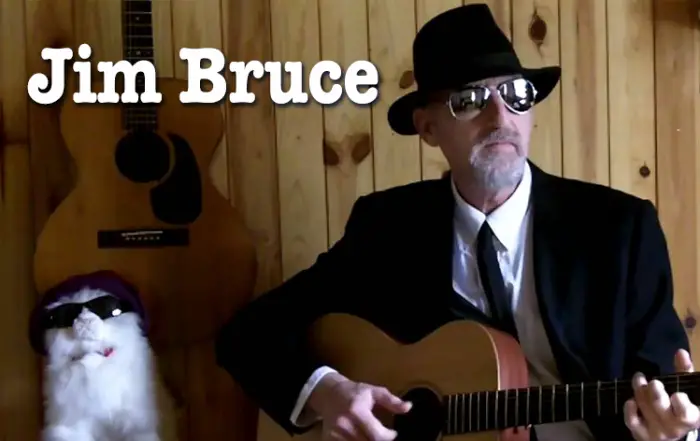- Open G Tuning Songs - Beginning With Open G Tuning and Bottleneck
- Open G Blues
- List Of Famous Blues Songs - Open G Songs
- Open G Tuning - Guitar Tuner
- Open G Blues Tabs - Learn Crossroads A Typical Blues Song In Open G
- Catfish Keith Article
- Delta Blues Tuning - Slide Guitar Songs In Open g
- Embedded Video Playlist Of Songs In Open Tuning
- Common Chords Used In Open G
- FAQ For Open G Guitar Tuning & Open G Chords
Watch Jim play 'Crossroads in Open G Tuning by Robert Johnson:
What is open G tuning on a guitar? Beginners guide to open tuning.

Guitar Tuning - Open G - DGDGBD.mp3
Open G Tuning - The Roots of the Blues
Open G Tuning Songs - Open G Blues Guitar Tuning
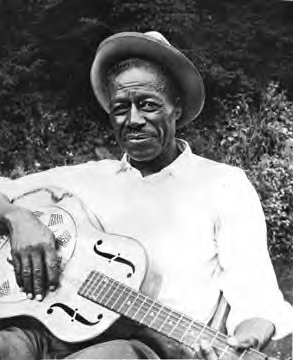
The video above opens with an old clip of me playing "Crossroads" by Robert Johnson on an old Johnny Joyce model Aria, and at 1:22, I start to explore open G guitar tuning from a beginner’s point of view. If you're looking for a starting point, you might want to check out the Crossroad Blues tab in open G.
It’s a simpler tuning than open D, and it’s perfect for playing with a bottleneck or slide. I use a thick glass bottleneck, which gives a different sound and feel compared to a steel or brass one – it’s a matter of choice.
Open G tuning is the most common example of open guitar tunings, and using a slide is by far the most common technique for this Delta blues tuning. The bottleneck way of playing guitar consists of letting the surface of the slide rest on the strings while we strum or fingerpick.
Many open G slide guitar songs rely on this technique. Generally, the guitar action needs to be higher than when playing normal guitar, so it’s a good idea to keep one guitar set up just for bottleneck. It’s a great idea to set up a ‘beater’ for this.
Damping the strings with one of your fingers behind the bottleneck is very important and takes a bit of practice – stick with it, because it’s the backbone of the technique. The actual open G tuning (2m:58s) is quite easy and involves taking just three strings down. The bass E comes down to D, the A string down to G, and the high E also comes down to D.
For those who are new to this tuning, you might start with some easy blues songs on guitar to get the hang of it. Chords in open G tuning are straightforward. In open G, the strings are tuned to the notes of a G major chord: D-G-D-G-B-D. This makes open G tuning chords very accessible and intuitive.
Exploring open G tuning guitar tabs can provide a wealth of songs to practice. Whether you're interested in classic open G slide guitar songs or open G licks, there are plenty of resources available. For instance, many songs in open G acoustic sound particularly full and vibrant, making them perfect for solo performances.
If you enjoy the sound of open tuning guitar G, you might also be intrigued by other tunings like the Skip James tuning (also known as open D minor). It's a good contrast to open G and can add variety to your playing. Additionally, learning open D blues songs can further expand your repertoire and understanding of blues music.
Overall, mastering chords in open G and becoming proficient with open G tuning guitar will open up a new dimension of blues playing. Whether you're playing acoustic or electric, the resonance and ease of this tuning make it a favorite among blues musicians. So, grab your guitar, look up some open G tuning guitar tabs, and start exploring the rich world of blues in open G.
Jumping Jack Flash - one of the most Iconic Stones Tunes in Open G Tuning
- Joni Mitchell
- Jimi Page
- Gary Clark Jr.
- Dire Straits
- White Stripes
- Howlin' Wolf
- Chet Atkins
TIPS FOR PLAYING SONGS OPEN G TUNING slide guitar style
Although some delicacy is needed to make a good sound, the technique is quite forgiving when moving along the fret board to a particular note. A ‘vibrato’ action is used so that the bottleneck is hardly ever still – it wavers around a note, producing those ethereal blue sounds.
One of the advantages of this is that you can slide up to a note, but don’t need to hit it spot on – you can vibrate the bottleneck and ‘fine tune’your position. This a major advantage of playing in this style for me. Effective damping with a finger of the fretting hand is important if the bottleneck is used in a way that doesn't span the 6 strings.
Blues is a very emotional type of music, and those who play it feel the emotions deeply. When you learn guitar in open g, bottleneck style can help express yourself in a new way. Another advantage of slide playing is that you don't need many chord shapes, often getting away with variations on one chord shape.
Bottleneck isn’t the only style we can play when we use this blues guitar tuning. Here I demonstrate a picking pattern I developed to play Mobile Texas Line, an unusual item among open G blues songs. It was originally strummed - see how you like it:
I've always had a love-hate relationship with open G blues tuning. Yes, it sounds great and it gives you the old authentic feel of the Delta blues, but for a long time I just could not stop those strings buzzing.
For many years I played folk music and during that time I was introduced to open D by a friend of mine. Of course this was finger-picking folk music and didn't involve a slide or a bottleneck.
I like the idea of open tunings but for a long time they were really a minor part of my repertoire, preferring to play Ragtime blues and Delta blues or fast Piedmont styles.
In particular I'd like to play Blind Blake tunes in open D, because some of them are slow, and some are fast and exciting. The slow pieces allow you to get into the music and to get into the chord structure of an open tuning, well the fast pieces are exciting when done well.
Open G or Open D?
In those days, I did try to play bottleneck style with open D but it never really worked out. it wasn't until much later that I heard open G for the first time played properly in the slide or bottleneck style.
When I was a younger player, like many people, I was quite arrogant. I loved to play complex guitar styles and I tended to ridicule styles that were either too simple or in another musical genre.
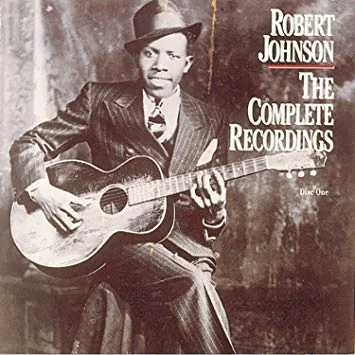
One night in the South of England, I happened to be in the folk club in a small village, listening to the amateur floor singers and waiting my turn to play.
Folk clubs are a fantastic way to learn the trade of playing in front of people. While sitting there, a man walked to the stage and prepared to play.
As he walked past me, I noticed that one of his guitar strings had a knot in it between the nut and the capo. On top of that, the strings were so old that they were green and rusty. I chuckled quietly and joked about this man, expecting to hear him play very badly.
He had only played two notes before I realized that this was something special. He fitted a glass bottle neck to his ring finger and moved it lightly over the strings to the 12th fret, before bringing it down to the 7th fret, and then the 5th fret, creating the most wonderful, plaintive blues sound. It was as though I was transported back to the Mississippi Delta. He didn't even play a full chord.
This was perhaps the biggest lesson I'd ever had in playing guitar. First of all, you don't need to be a technical genius or be a fantastically complex finger picker to produce some wonderful blues music.
Secondly, a good guitar player will adapt to his instrument and the strings that he has. This is the genius of playing the Blues. It's a feeling more than technique.
In the case of this young man, the state of the strings actually helped produce that authentic old sound. New guitar strings tend to have a bright and lively sound, which doesn't translate well into the old blues. In addition, the windings of the lower gauge phosphor bronze strings tend to be raised and make quite a scraping sound as the bottleneck is pushed along.
If you are intending to play in the bottleneck style a lot, or almost exclusively, it's probably a good idea to use flat-wound strings. It really doesn't matter if they are nickel steel bronze or phosphor bronze, but I find that the bronze style strings produce a warmer sound. As with all strings, it’s a personal thing and it's always best to try a few sets before you decide.
His performance inspired me to explore more easy blues guitar songs and experiment with open G guitar chords and blues tuning. Slide guitar tuning in open G offers a distinctive sound that captures the essence of blues in G.
Discovering blues tabs and g tuning guitar techniques became a new passion, especially exploring open G tuning slide guitar for blues guitar songs.
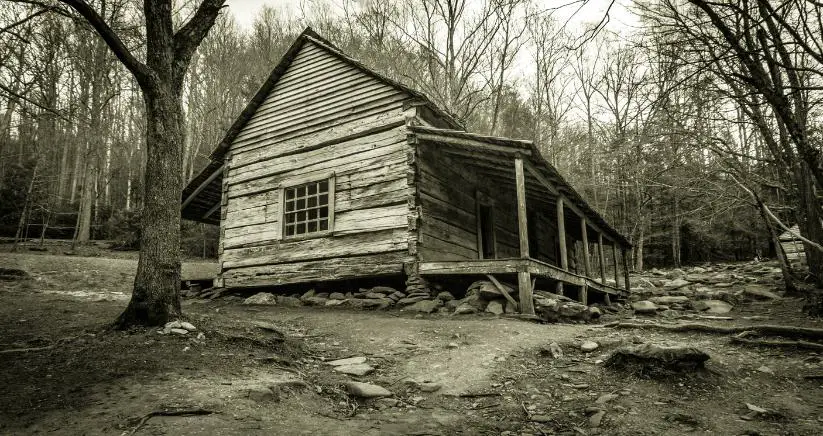
Kassie Jones Part 1 FURRY LEWIS (1928) Blues Guitar Legend.mp3
Muddy Waters (acoustic) at Newport 1968 Walkin Blues.mp3
Son House Death Letter Blues.mp3
Robert Johnson- Crossroad.mp3

Open G - Crossroads Intro Tab 1.mp3

Open G - Crossroads Intro Tab 2.mp3
Open G - Crossroads Intro Tab 3.mp3
This article below is a great example about using open G tuning for slide guitar - Catfish Keith is a master of the style and plays in nothing else! (Almost!)
The Voice of the Blues
~ by Catfish Keith ~
Article in Fingerstyle Guitar, Issue 19, Jan-Feb 1997
Nothing knocked me out more than the first time I heard solo country blues. I was coming up as a teenager, in Davenport, Iowa, and one day I heard my first Son House number, "Death Letter". That was it! Wow!
From that moment on, I was hooked on that crying, singing sound that still makes my hair stand up. I couldn't believe how much music was coming from just one person. The combination of stomping feet, deeply felt vocals, and propulsive, from-the-gut, string-popping slide guitar left my jaw dangling to the ground. I was floored by this music. My life was changed forever.
While my high school buddies in the 1970s were into disco and heavy metal, I went deeper and deeper with my mission of discovering the very roots of American music, and found a treasure trove of exciting, obscure musical gems from Mississippi delta blues masters like Charley Patton, Booker White, Mississippi Fred MacDowell, Johnny Shines, Willie Brown, Tommy Johnson, Mississippi John Hurt, Robert Johnson, and Son House to ragtime blues guitarists like Blind Blake, Blind Boy Fuller, Big Bill Broonzy, to sanctified pickers Blind Willie Johnson, Rev. Gary Davis, and Rev. Robert Wilkins.
Often, one guitarist made the sound of two or three guitars, playing bass, rhythm, melody, harmony, and counterpoint at the same time! There were also many other influences and styles working their way into my repertoire, including early jazz of Louis Armstrong, Jack Teagarden, and Bix Beiderbecke, island music of the Caribbean and Hawaii, with Joseph Spence and Sol Hoopii as major heroes.
Old-time fiddle tunes, zydeco, and New Orleans R&B were in there too. Needless to say, nobody at school had any idea what I was talking about! But I didn't care. I was just tickled to be soaking up this great music.
Times have changed since those days of years ago. Early recordings of the 1920's and '30s, once almost secretly passed from the hands of one zealot 78 record collector to another, are now available on Compact Disc compilations in chain stores for everyone to enjoy. Hundreds of new and old blues recordings are released every year on major and independent labels.
Blues festivals and blues societies have sprung up all over the U.S. and abroad, and a handful of blues-based artists have become certified rock stars. Blues is the soundtrack for beer and soap commercials.
You can learn the notes easily from mountains of books, videos, and at guitar workshops. Blues legends are working and touring more than ever. Times have never been better for the blues.
Bottleneck Slide Guitar - SLIDE GUITAR SET-UP
To play slide, you must first have your guitar set up properly for the best tone and playability. On my albums and live, until about 1998, I've played on my 1930 National steel-bodied Style O resonator guitar.
These are great sounding old guitars, especially for slide and delta blues. Many blues, jazz, hillbilly, and Hawaiian guitarists played Nationals, and before the electric guitar caught on, were the loudest, shiniest, funkiest guitars available.
In recent years I've been favoring my 1999 National Baritone Polychrome Tricone guitar (pictured below) from National Reso-Phonic Guitars in San Luis Obispo, California. This has been my main thing ,touring and recording steel-bodied National since the day I got it.
This special instrument has a longer scale length (a couple inches longer than a standard National neck) and is tuned lower (see below). The strings are also quite a bit heavier (.068-.017 on mine). The neck meets the body at the 13th fret , and adds two more frets to the length of the neck, and enables you to go 3-5 half steps lower than normal.
I'd been seeking this huge, deep tone for quite some time and the cats at National Reso-Phonic really came through with a revolutionary, very special guitar for me. Because of the Baritone Tricone's popularity, this is an in-demand catalog item for them now, and is available usually by special order.
If you are interested in buying a new National (of any kind), please email or call, I'd be happy to help. I've assisted lots of folks get their dream guitar, and, by special arrangement with National, I can get you prices as good or better than most dealers (always 20% off list price and no sales tax unless you live in Iowa). Also, I'm always available for any and all advice I can lend about these great instruments.
You can set up any steel-string acoustic guitar for slide. The nut of the guitar must be slightly higher (around the thickness of a matchbook cover), so the strings are higher over the fretboard than for regular guitar playing. You should still be able to fret the strings as well as slide comfortably without clonking the frets with the slide. A qualified guitar repair person should be able to set you up right.
Note: BE CAREFUL choosing a repair person. Try to get a couple of (or lots of) recommendations from respected players before taking your dear guitar into the shop.
SLIDING STRINGS
For the best slide tone for your guitar, heavier gauged strings, especially on the top two treble strings, are generally better. I use these gauges on my 1930 Style O and 1998 Delphi Nationals, in Phosphor Bronze:
Low to High: .056 .045 .035 .026 .019(plain) .017(plain)
On my Baritone National, I use these gauges, also in Phosphor Bronze:
Low to High: .068 .056 .042 .030 .019(plain) .017(plain)
CAUTION: Many acoustic guitars are not made for heavy string tension. Be careful not to put strings on your guitar that are heavier than the recommended gauges.
IMPORTANT: Don't tune your guitar too high! It could pull some (especially wooden acoustic guitars) apart! Tune no higher than a D or G-tuning, and if you notice the bridge area raising on your acoustic guitar raising, use lighter gauge strings. The new Nationals are pretty tough, with double truss rods, but they say if you tune to an E or A Tuning, take the tension off the strings before putting the guitar away.
OPEN TUNINGS FOR SLIDE PLAYING
Although there are dozens of variations, I use these two traditional open chord tunings for slide, often flatted a half step:
· Open-D, Vasserpoo or Vestibule Tuning. Low to High: DADF#AD
· Open G, Spanish or Hawaiian Tuning. Low to High: DGDGBD
On the Baritone National, I use the same tunings, only pitched lower, starting at B or B-flat.
FINGERPICKS OR NAKED FINGERS?
I use a large plastic thumbpick on the right hand thumb, and two metal fingerpicks for the index and middle fingers, but for me, especially on the steel guitar, picks help make a sharper, louder tone and help save your fingers.
GET A GOOD SLIDE
There are many kinds of slides to choose from; everybody has a different preference. Some use a metal tube or pipe (Son House used a piece of copper tubing), or a spark-plug socket. These have a brasher, more metallic tone, but have the advantage of being shatterproof (and multi-purpose).
Some of the old-time slide guitarists used a knife. Cedell Davis used a butter knife. Legend has it that Blind Willie Johnson used a straight razor for a slide. Makes for a sharper tone, but sounds mighty dangerous!
My preference is a glass slide, made from a wine bottle. Glass has a weepier, richer sound than metal. You can make your own or buy commercially made slides in the music stores, and remember the thicker the glass, the thicker your tone will be.
The glass in many wine bottles (the kind with corks, not screw-on tops) is nice, thick, and smooth, and makes for the best sound. You can also buy slides online, just like mine (pictured below), through this website, individually handmade from wine bottles by Roger Gohl of Sly Devil Slides in Los Angeles. Email me if you want more info on custom lengths, double cut slides, etc.
PUT IT ON YOUR PINKIE!
Putting your slide on your left hand pinkie finger leaves your other left hand fingers free to fret notes and make chords without the slide, and also to damp the strings behind the slide. Some guitarists like Son House and Bonnie Raitt use the slide on the ring or middle finger, but generally, having the slide on your pinkie is the best bet.
SLIDE PLAYGROUND
Unlike fretting the strings, playing with the bottleneck involves setting the slide directly above a fret, with light pressure on the string with the slide when plucked. Try it on the high D (first) string in Open-D tuning, with the slide angled slightly away from the neck, so you are only resting the slide on the high string.
Then, pluck the string with your right hand index finger, and slide up the neck slowly from the third fret to the fourth fret. Ahhh!! Vibrate the slide slightly (left & right) along the string at the end of the phrase to give it that vibrato like a gospel singer. That's it!
The difference between playing slide and regular guitar is like the difference between a violin and a ukulele. Think of the slide as a woman's voice. Some of the notes will be bent or "blue" notes that are 1/4 to 2/3rds above the fret. The ability to bend and vibrate these vocal-sounding notes is what makes slide guitar so haunting.
Article Source: http://www.catfishkeith.com/fingerstyleguitararticle.htm
Songs In Open G Tuning Guitar
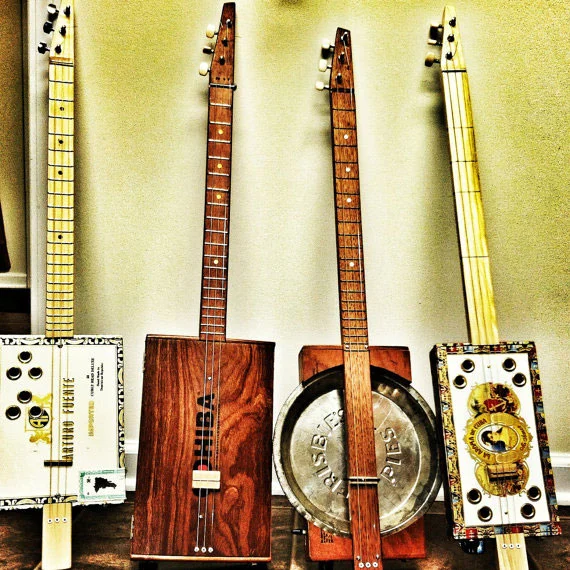
Slide Guitar Songs In Open G
Open G Chords
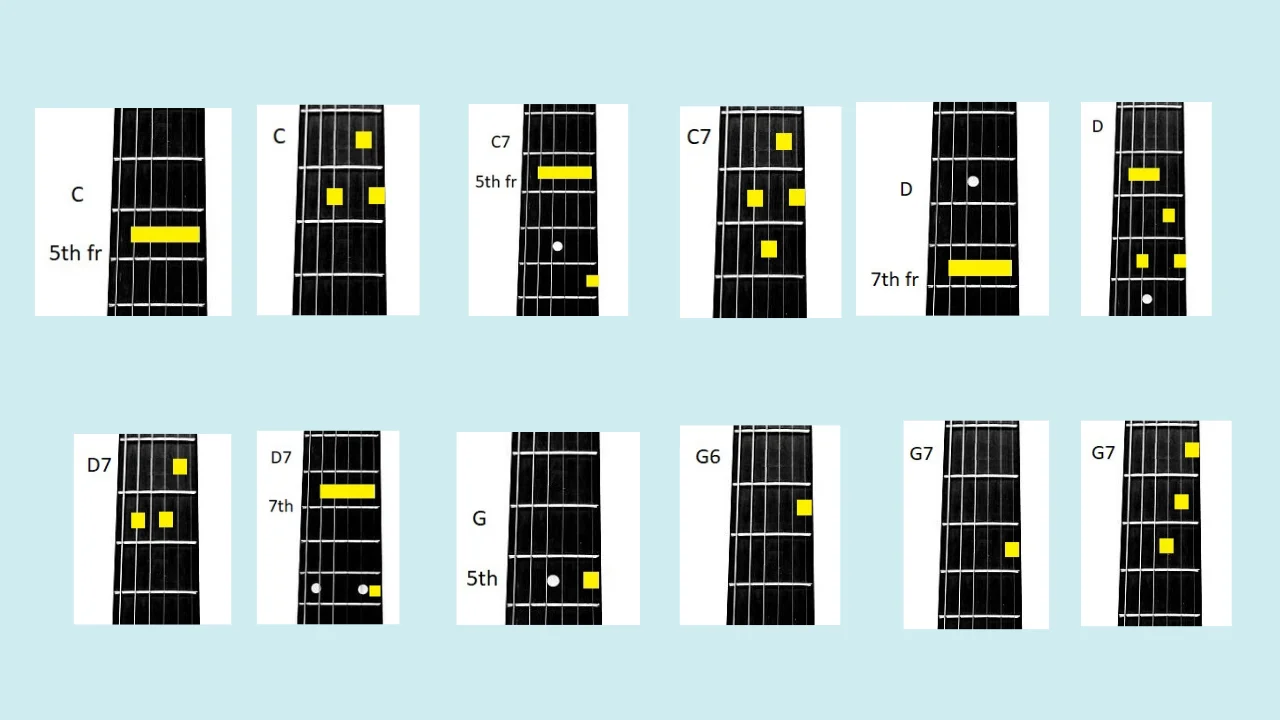
Open G Guitar Tuning FAQ
Open G Tuning originated in the Mississippi Delta, probably because it was easy to keep in tune in hot, humid conditions
Yes, it is! Open G is a favourite of Keith Richards and many Rolling Stones songs were written in this tuning
What songs are in open G?Walkin' Blues is very similar to Crossroads. Pick up the licks and adapt it!
There are just too many to list, but here are some notable ones. The list doesn't include the many old classic blues songs.
- The Black Crowes - Hard to Handle, Twice as Hard
- Coldplay - High Speed
- Robert Johnson - Walkin' Blues (also covered by Eric Clapton)
- Led Zeppelin - Black Country Women,In My Time of Dyin',Going to California
- Pearl Jam - Daughter
- Pink Floyd - Fearless
- Rolling Stones - Can't You Hear Me Knockin', Brown Sugar, Happy, Honky Tonk Women, Jumping Jack Flash, Start Me Up
- George Thorogood - Bad to the Bone
Slide or bottleneck guitar is almost always played withe guitar tuned down to open G
- Open A option 1 - E-A-C♯-E-A-E
- Alternatively: E-A-C♯-E-A-C♯
- Alternatively: A-E-A-E-A-C♯ (one step down from Open B)
- Use for slide playing: E-A-E-A-C♯-E (identical to Open G tuning but with every string raised one step or two frets)
You can play any style you like and many modern songs use open tunings. The old blues men often used open G, but many modern performers used hybrid tunings. For example, Joni Mitchell said she used about 50 during her career!
An open tuning is when a guitar is tuned down (or, very rarely, up) so that it plays a chord when the strings are strummed open. Common tunings are Open G, Open A and Open D.
In the only photos of Johnson existing he is holding a 1920s Gibson L-0 or Kalamazoo KG-14, but maybe these were provided by the recording company.
It depends on what you want to play. Delta Blues bottleneck or slide is often played in Open G. Open D is good for fingerstyle folk and blues, but open G is easier, with just 3 strings to tune down.
List of acoustic blues songs written in open G guitar tuning
"Dust My Broom" by Elmore James
"Dust My Broom" is a blues song written by Elmore James, an American blues musician. It is an uptempo blues song that features James' distinctive slide guitar playing and his powerful, emotive vocals. The song is based on an earlier blues song called "I Believe I'll Dust My Broom," which was recorded by Robert Johnson in 1936. James' version of the song features updated lyrics and a faster tempo.
Here are the lyrics to "Dust My Broom" by Elmore James:
I'm gonna dust my broom, I'm gonna move on down the line I'm gonna dust my broom, I'm gonna move on down the line Well, I'm tired of these women, they're trying to treat me so unkind
I'm gonna buy me a ticket, I'm gonna ride to the end of the line I'm gonna buy me a ticket, I'm gonna ride to the end of the line Well, I'm tired of these women, they're trying to treat me so unkind
I'm gonna leave this town, I'm gonna leave this town and never come back again I'm gonna leave this town and never come back again Well, I'm tired of these women, they're trying to treat me so unkind
I'm gonna buy me a ticket, I'm gonna ride to the end of the line I'm gonna buy me a ticket, I'm gonna ride to the end of the line Well, I'm tired of these women, they're trying to treat me so unkind
I'm gonna buy me a ticket, I'm gonna ride to the end of the line I'm gonna buy me a ticket, I'm gonna ride to the end of the line Well, I'm tired of these women, they're trying to treat me so unkind
"Sweet Home Chicago" by Robert Johnson
"Sweet Home Chicago" is a blues song written by Robert Johnson, an American blues musician who is widely regarded as one of the greatest blues guitarists of all time.
The song is a classic 12-bar blues structure and features Johnson's virtuosic guitar playing and his powerful, emotive vocals. The lyrics describe the city of Chicago as being a place where the blues can be enjoyed and where the singer feels at home.
Here are the lyrics to "Sweet Home Chicago" by Robert Johnson - join diehard blues fans of Johnson and spread his music:
Come on, baby, don't you wanna go Come on, baby, don't you wanna go Back to that same old place, sweet home Chicago
The bus is comin', don't you wanna ride The bus is comin', don't you wanna ride Back to that same old place, sweet home Chicago
Oh, baby, don't you wanna go Oh, baby, don't you wanna go Back to that same old place, sweet home Chicago
The police will shoot a dude, dude looks like me The police will shoot a dude, dude looks like me I don't want no trouble, I just want to be
Come on, baby, don't you wanna go Come on, baby, don't you wanna go Back to that same old place, sweet home Chicago
"Death Letter Blues" by Son House
"Death Letter Blues" is a blues song written and performed by Son House, an American Delta blues musician. The song is a slow, mournful blues that features House's raw and powerful vocals and his virtuosic slide guitar playing. It's a real gift handed down to future generations.
The lyrics tell the story of a man who receives a letter informing him that his lover has died. The man is devastated by the news and laments the loss of his love.
Here are the lyrics to "Death Letter Blues" by Son House:
I got a letter this morning, how do you think it read? Oh, I got a letter this morning, how do you think it read? "Your baby's dead, and gone, won't be back no more"
I got a death letter, Lord, won't you tell me what I'm gonna do? Oh, I got a death letter, Lord, won't you tell me what I'm gonna do? I'm gonna lay down and die, Lord, I'm tired of living without you
I went to the graveyard, Lord, and I stood at the foot of the bed I went to the graveyard, Lord, and I stood at the foot of the bed I said, "Lord, Lord, I wonder if she's dead or if she's dead?"
I went to the graveyard, Lord, and I stood at the head of the bed I went to the graveyard, Lord, and I stood at the head of the bed I said, "Lord, Lord, I wonder if she's dead or if she's dead?"
"Catfish Blues" by Robert Petway
"Catfish Blues" is a blues song written and performed by Robert Petway, an American blues musician. It is a slow, bluesy song that features Petway's distinctive guitar playing and his rough, raw vocals.
The lyrics tell the story of a man who is feeling down and out because his lover has left him. He compares the feeling of being abandoned to a catfish swimming in the deep, dark water, and he laments the fact that he is all alone. Despite this, he vows to keep on living and keep on playing the blues.
Here are the lyrics to "Catfish Blues" by Robert Petway:
I'm feeling just like a catfish, swimming in the deep blue sea I'm feeling just like a catfish, swimming in the deep blue sea I'm all alone, ain't got nobody, to care for me
I'm going down to the river, see if I can find my gal I'm going down to the river, see if I can find my gal But if I don't find her, I'll just lay down and die
I ain't got nobody, to call my own I ain't got nobody, to call my own I'm just a lonely catfish, swimming all alone
But I'm gonna keep on living, and I'm gonna keep on playing the blues I'm gonna keep on living, and I'm gonna keep on playing the blues 'Cause the blues ain't nothing, but a lowdown feeling, deep inside of you
"Long Tall Woman Blues" by Bukka White
"Long Tall Woman Blues" is a blues song written by Bukka White, an American Delta blues musician. It is an uptempo blues song that features White's distinctive slide guitar playing.
The lyrics tell the story of a man who is in love with a tall woman who he describes as being "long and tall, just like a matchstick." The song has become one of White's most well-known and popular recordings.
Here are the lyrics to "Long Tall Woman Blues" by Bukka White:
Well, I got a long tall woman, she's just like a matchstick I got a long tall woman, she's just like a matchstick I'm gon' set her on fire, let her burn
Well, I got a long tall woman, she's just like a matchstick I got a long tall woman, she's just like a matchstick I'm gon' set her on fire, let her burn
Well, I got a long tall woman, she's just like a matchstick I got a long tall woman, she's just like a matchstick I'm gon' set her on fire, let her burn
Well, I got a long tall woman, she's just like a matchstick I got a long tall woman, she's just like a matchstick I'm gon' set her on fire, let her burn
"I Be's Troubled" by Muddy Waters
"I Be's Troubled" is a blues song written and performed by Muddy Waters, an American blues musician who is widely considered one of the greatest blues artists of all time. The song is a classic 12-bar blues structure and features Waters' powerful vocals and his virtuosic guitar playing.
The lyrics tell the story of a man who is going through a tough time and is feeling troubled and down. Despite this, he remains resilient and determined, and he knows that he will eventually overcome his troubles.
Here are the lyrics to "I Be's Troubled" by Muddy Waters:
I be's troubled, I be's worried, I be's troubled, baby, every day I be's troubled, I be's worried, I be's troubled, baby, every day I got troubles of my own, I don't need nobody else's troubles to weigh me down
I got the blues, they way down in my heart I got the blues, they way down in my heart The blues ain't nothin' but a heartache, a trouble, the blues
I'm goin' down to the river, gonna take me a rockin' chair I'm goin' down to the river, gonna take me a rockin' chair Gonna rock away my troubles, baby, ain't never comin' back no more
"Come On In My Kitchen" by Robert Johnson
The lyrics tell the story of a man who is trying to convince a woman to come into his kitchen and keep him company. He tells her that he is lonely and he wants her to stay with him, even if it means just sitting in the dark. The song has become one of Johnson's most popular and enduring recordings.
Here are the lyrics to "Come On In My Kitchen" by Robert Johnson:
Come on in my kitchen, baby, it's goin' to be rainin' outdoors Come on in my kitchen, baby, it's goin' to be rainin' outdoors You ain't got no home to go to, baby, don't you be no back door man
I've been mistreated and I don't mind dyin' I've been mistreated and I don't mind dyin' Well, if you see me dyin' and a-cryin', baby, hmm, it's been all in your hand
I'll give you my seat and you can sit down in my chair You can sit down in my chair, baby, I'll give you my seat Well, it's goin' to be cold, cold, rainin' outdoors, don't you be no back door man
"Rain" by The Beatles
"Fearless" by Pink Floyd
"Can't Get Enough" by Bad Company
"Easy to Slip" by Little Feat
"Tumbling Dice" by The Rolling Stones
Other lessons:
Picks or Bare Fingers?
The Thumb Is King
The Blues In E
The Blues In A
Dropped D and Open D
Songs In Open G and Bottleneck
Ragtime Picking
